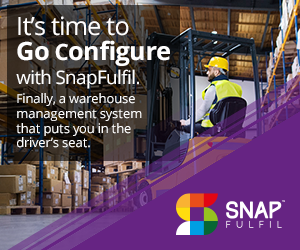Smarter technology investment for the new world order
The impact of COVID-19 has brought into sharp focus the need for agile solutions to meet sudden changes to business operations - says SnapFulfil CEO, Don White.
Traditional business models are being turned upside down and facility rentals are soaring as brands try to capitalize on the ecommerce trend with a direct to consumer [DTC] offering, so it's more critical than ever to consider the warehousing and logistics part of the supply chain.
The solution sits with advanced, digital technology, which is central to tackling new challenges and optimizing premium fulfillment center space. It is also key to satisfying more demand, staying competitive, plus managing labor efficiency and productivity.

The required changes – particularly the shift from wholesale to individual order dispatch –isn’t an easy move. The days of distribution centers designed for bulk ‘pallet in, pallet out’ operations are numbered. And when the space is coming with a premium price tag, it’s essential that the warehouse management system [WMS] has the capabilities to effectively support smaller, incremental orders in the thousands.
This is where highly adaptable, cloud-based WMS like SnapFulfil is specifically engineered to meet the needs of an ever-evolving marketplace without being expensive or time consuming to set in motion and reconfigure. In fact, it is possible to be up and running in under 60 days – and that’s even in a remote implementation scenario.
Having the capability to switch things up quickly is essential as the latest U.S. Department of Commerce data shows e-commerce accounted for 51.2% of all retail growth across North America, with online sales growing by 15.1% compared to total retail sales growth of 3.5%. That accounts for the growth in e-commerce penetration of U.S. retail sales from 6.4% in 2010 to 16.0% in 2019.
A natural consequence is that the digital transformation of business will continue apace, with more automation to control stocks, fulfillment and delivery - and an intuitive WMS is an integral part of the new ecommerce world order.
A tier 1 WMS will integrate with other solutions, creating a valuable ‘blockchain’ network of peer-to-peer transactions. This lets firms share information about a container just once, but everyone up and down the chain can see that data in an instant. Bosses can also access a real-time bird’s eye view of their business allowing them to make better, more efficient decisions based on solid data – essential in disruptive markets and with margins ever tighter.
Through blockchain technology, companies are also waking up to the value of the customer data trail and the loyalty they can harness through having a single customer view. This can only be achieved through integration and mapping each customer’s buying journey from start to end and beyond. And fulfillment is part and parcel of that.
Data analysis drives much of the decision making in business, which is why it is so important for companies to understand their past and current performance and challenges in order to succeed in the future. Consequently, a WMS must be able to deliver those key business metrics, while at the same time enable operations to evolve in a fast-moving environment. It must provide flexibility, stable integration and a pace of implementation that doesn’t require lengthy, expensive and risky development cycles.
DTC operations are in stark contrast to bulk or retail-based shipping, so a technologically advanced WMS can really help keep goods and processes flowing, while managing staff and resource allocation, through the targeted data it collects and delivers. Savvy businesses are using data to identify trends and make important operational and fulfillment decisions based on a strategic version of their truth and solid analytics.
For example, when labor is at a premium and self-isolation is a reality, coupled with a rapid change in orders, then having data to boost the effectiveness of the available workforce, their picking and packing performance, plus available space– underpinned by highly efficient receiving and put-away activity – is crucial.
Data driven WMS also allows you to take a fresh look at shipping visibility and accuracy. There is an ever-growing expectation from consumers for fast and accurate order fulfillment and during a recession, business can be hard to win but easy to lose due to disgruntled purchasers. Incremental improvements in visibility and error reduction, however, will yield proportionately greater benefits to sales growth and customer retention.
All said, agile and easily configurable WMS is now a business critical fulfillment function and change is no longer a luxury – it is a necessity in order to survive and thrive.



